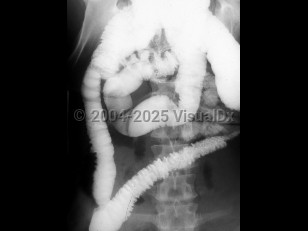Amebic colitis in Adult
Alerts and Notices
Important News & Links
Synopsis

A cause of dysentery due to the parasite Entamoeba histolytica.
The protozoal cyst is transmitted by the fecal-oral route, usually after ingesting contaminated water or food. Following excystation, the organism invades the colon.
The highest risk of infection is in settings with poor sanitation levels and low socio-economic conditions. In the developed setting, men who have sex with men are at increased risk for amebiasis. Patients taking corticosteroids, pregnant patients, malnourished patients, or patients who are very young or old are at risk for severe disease.
The majority of infections are asymptomatic, with the likelihood of invasive disease depending on the strain of E histolytica involved and the host characteristics. Patients with invasive disease present with dysentery and may appear systemically ill at presentation. They have loose bloody (either grossly or microscopically) stools with mucus. Abdominal cramps are common, and abdominal pain may be very severe. Fever may be present, but it is not seen in all patients. For most patients, these symptoms develop and worsen over about 3-4 weeks before they present for medical care. Some patients may present with more acute symptoms that may be difficult to differentiate from bacterial dysentery. For other patients, the symptoms may worsen over the course of months.
Complications of amebic colitis include intussusception, perforation, and peritonitis. Rarely, toxic megacolon may occur.
The condition is not typically life-threatening unless the patient is presenting with a rare complication of the disease like necrotizing colitis.
Related topic: Cutaneous amebiasis
The protozoal cyst is transmitted by the fecal-oral route, usually after ingesting contaminated water or food. Following excystation, the organism invades the colon.
The highest risk of infection is in settings with poor sanitation levels and low socio-economic conditions. In the developed setting, men who have sex with men are at increased risk for amebiasis. Patients taking corticosteroids, pregnant patients, malnourished patients, or patients who are very young or old are at risk for severe disease.
The majority of infections are asymptomatic, with the likelihood of invasive disease depending on the strain of E histolytica involved and the host characteristics. Patients with invasive disease present with dysentery and may appear systemically ill at presentation. They have loose bloody (either grossly or microscopically) stools with mucus. Abdominal cramps are common, and abdominal pain may be very severe. Fever may be present, but it is not seen in all patients. For most patients, these symptoms develop and worsen over about 3-4 weeks before they present for medical care. Some patients may present with more acute symptoms that may be difficult to differentiate from bacterial dysentery. For other patients, the symptoms may worsen over the course of months.
Complications of amebic colitis include intussusception, perforation, and peritonitis. Rarely, toxic megacolon may occur.
The condition is not typically life-threatening unless the patient is presenting with a rare complication of the disease like necrotizing colitis.
Related topic: Cutaneous amebiasis
Codes
ICD10CM:
A06.2 – Amebic nondysenteric colitis
SNOMEDCT:
235747003 – Amebic Colitis
A06.2 – Amebic nondysenteric colitis
SNOMEDCT:
235747003 – Amebic Colitis
Look For
Subscription Required
Diagnostic Pearls
Subscription Required
Differential Diagnosis & Pitfalls

To perform a comparison, select diagnoses from the classic differential
Subscription Required
Best Tests
Subscription Required
Management Pearls
Subscription Required
Therapy
Subscription Required
References
Subscription Required
Last Updated:04/15/2018

